2 - An
introduction to Acoustics and Hearing
2.1
- Hearing - Part 1
2.2 - The Association Model of Perception
2.3 - Perception of the world around us
2.4 - Perception and the perceiver
2.5 - Hearing - Part 2
2.6 - In summary
SL: So now let's talk about acoustics
and how acoustic phenomena relate to hearing phenomena. Both occur in
time and space.
Fitz: You mean space like my living
room or backyard?
SL: Yes, any volume of air that has
objects in it and hard boundaries and where people are.
Fitz: I hope you focus on my living
room, because that's where my new loudspeakers will go.
SL: Correct, but not exclusively so.
Rooms have different sizes and that matters acoustically. You describe
the floor area in square-meters and the length, width and ceiling height
in meter or use feet and square feet for it here in California. But for
acoustics those room measurements carry no meaning unless they are
translated into wavelength of sound.
Fitz: My room is 12 feet by 18 feet
with 8 foot ceiling and I have been told that it may be acoustically too
small for my speakers with all the stuff that we have in the room. Also,
SWMBO is not too happy and the speakers must be small or there is no
chance to set them up.
SL: Oh well, everyone has their
problems. Acoustic dimensions can tell you at least where the
acoustic problems of your room and your speaker design are likely to
occur.
SL: Sound travels at a speed of 344 meters
per second. If the sound is caused by a periodic vibration that repeats
itself every "t" seconds, then the vibration has a frequency
of F = 1/t Hertz.
Say it repeats every millisecond, then the
frequency is 1 kHz.
Since this vibration travels through the
air at a speed of 344 m/s it repeats at distances of 344 mm, which is
called its wavelength.
I show you these relationships in spreadsheet
format:
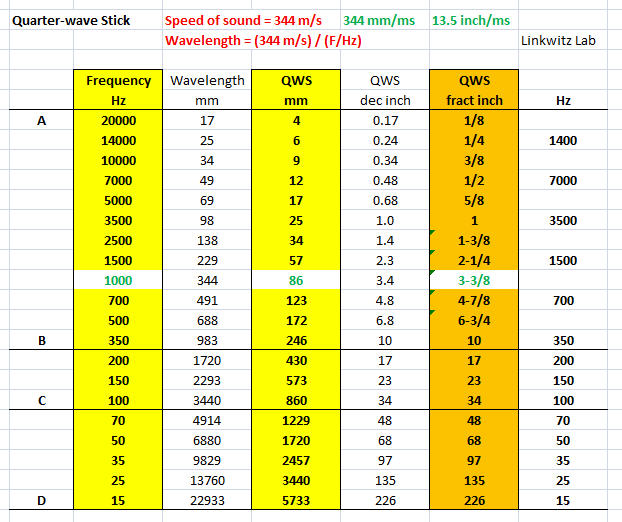
Fitz: Wow, from 20000 Hz
to 15 Hz the wavelength changes by a ratio of 1333 to 1.
SL: Yes. But what matters
for the acoustic design of your speaker cabinet and baffle size or for
your living room dimensions is not the wavelength, but the
quarter-wavelength.
Fitz: Why is that?
SL: We will get to that.
But basically, when you have a sinewave it has phase-shifted 90 degrees in
1/4th of its period or a quarter-wavelength. Significant acoustical
phenomena and interactions occur when two waves are separated by a quarter
wavelength or multiples of a quarter-wavelength.
If some object is much smaller in
physical size than 1/4th of the sound's wavelength, which hits it, then it
is called acoustically small. The sound just travels around the object
pretty much unimpeded. If it is 1/16th of a wavelength in size you can
forget about it.
For example, take your 4" x
4" tweeter baffle. At 3.5 kHz a quarter-wavelength measures 1".
So the baffle is acoustically large and gets even larger as frequency goes
up. The quarter-wave boundary between large and becoming small is in this
case at 13.5 mm/s divided by 4 times 4 inch, which equals 0.84 kHz or 840
Hz.
Fitz: Are you saying that
"acoustically large" is a prescription for trouble?
SL: No, not at all. All I am
trying to say is that you better understand what the effect of
"acoustically large" is for your speaker design and how
directionally your speaker will radiate sound into your living room.
Fitz: But then we should
really look at the ribbon, which makes the sound. It is much smaller.
SL: Yes. I estimate the
ribbon to be 10 mm wide and 50 mm long. That would give for the width:
Fquarter = 344 mm/ms / 4x10 mm = 8.6 kHz and for the length:
Fquarter = 344 / 4x50 = 1.7 kHz
Fitz: And that means?
SL: That you can expect
vertical directivity effects, like narrowing of the vertical beam and more
than one beam in the vertical plane of radiation.
Fitz: And is that
undesirable?
SL: It depends upon what
you had in mind for the radiation pattern of your speaker. But be aware
that the polarity between beams changes. At the same time when the air
particle density of the main beam aimed at you increases, the air particle
density decreases in the next beam, aiming towards the ceiling or floor of
your room.
Fitz: I fail to see the
significance of that sort of beaming and in any case the ribbon is narrow
in the horizontal plane and that is where sound dispersion really matters.
At 10 mm width Fquarter is 5-times higher and at 8.6 kHz.
SL: We will get into the
audible significance of radiation pattern later. At this point I just need
to tell you that you are not alone. I look at commercial at consumer and
professional loudspeakers and without hearing them I can pretty much tell
you how they will sound in a room. By visual inspection I can tell how
much attention has been paid to their acoustical design, which determines
with what strength they radiate sound in directions different from
"on-axis".
I think it is essential to remember
some numbers from the spreadsheet and to form a mental image of
them.
The speed of sound is c = 344 mm/ms, thus a quarter wave at 1
kHz is 86 mm long.
A 100 mm physical dimension
corresponds to a quarter-wavelength of
QW = 344 / 4x100 = 0.86 kHz = 860 Hz
You can mark up a ruler with the
numbers from A to B, or a yardstick with the numbers from A to C to get a
feel for the bottom boundary of acoustically large expressed in kHz and
mm. You will need a tape measure to cover A to D.
Fitz: I will have to
digest "acoustic size" and try to see it.
SL: Use your Design #3 for
that. And also look at your room. Above which frequency is it acoustically
large?
And note that
if some object is acoustically small, then the wave travels around it
unimpeded.
If it is an acoustically small source, then the wave propagates outwards
from it like the surface of an expanding sphere. A point source radiates
omni-directionally.
Think of the point source as a pulsating
sphere.
But a back and fore moving sphere, like a ball at the end of an infinitely
long pendulum string, is called an oscillating sphere. If it is
acoustically small, then it radiates sound in dipole fashion. It does not
radiate in the plane that is at right angle to the axis of movement.
A few days later:
Fitz: Glad that I run into
you. I calculated QW for my room and for the length I get 17 Hz. That does
not seem right because I know that my lowest room mode is at 34 Hz and
below that frequency I supposedly get pressure buildup in the room.
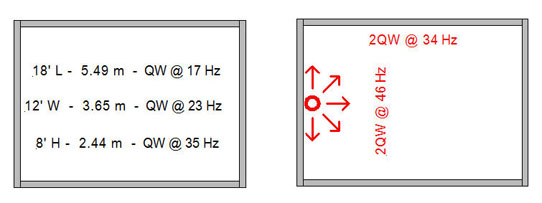
SL: 34 Hz is correct and
that is the result of 2 quarter-wavelength sections or a half-wavelength
equaling the length of your room. Nasty and sometimes desirable acoustic
phenomena occur at distances that are multiples of a quarter-wavelength. QW
is a useful unit of measurement.
For example, if you remove the back
wall from your room so the sound can travel right to your neighbors, then
you would hear at 17 Hz a loud quarter-wave resonance when you stand in
the opening.
If instead of removing the wall you
think of extending your side walls to infinity then the sound wave never
encounters a discontinuity and no sound reflects back to the
source. QW goes to zero and no standing wave can exist in that direction.
A structure like this is called a wave-guide. The structure with
the opening is called a quarter-wave resonator. And your room
structure is called a closed-cavity when it comes to acoustic
fields and waves.

SL: But I am getting way
ahead of what I want to talk about.
But we will get back to this later and to more cases, like when the side
walls recede and only the front wall remains.
And then what happens to the wave when that last boundary shrinks to zero
and only the point source of output strength "1" remains?
By the way that is the same strength source in all the pictures. Because
the source is directly in front of a wall it generates twice the sound
pressure as it does in free-space. But only as long as the wave has
a sufficiently large guiding wall. It has that for frequencies above 46 Hz
in our example.
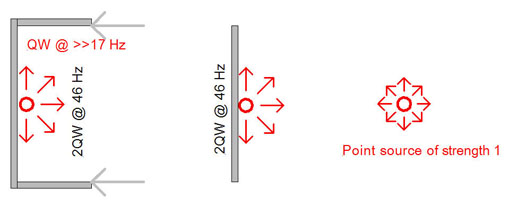
SL: Think about all this
before I continue and talk about hearing. Look at your Design #3.
Think about the baffle size and the room behind the 8" driver. What
are their QW frequencies? And what does that mean?
2.1
- Hearing - Part 1
SL: The Zen master asks
the student: "When a tree falls in the forest, does it make a
sound?"

And the student thinks: "That must
be one of his trick questions again, I must think before I answer. I know
when the tree falls that it makes noise when its branches hit other trees
and branches and that it makes a loud crash when it hits bottom. so why is
he asking?"
Fitz: I get it! Somebody
has to be there to hear it. Otherwise it's just air vibration. Sound is
what I hear. What I perceive and then associate with branches moving
against other branches.
SL: The Zen master also
asks: "What is the sound of one hand clapping?"
Fitz: That does not make
any sound. But I can hear clapping in my mind. So the sound of one hand
clapping is referring to a memory.
SL: Sounds reasonable to
me, but then I am not a Zen master to know why he asked the questions. I
suspect he is inquiring about the student's Self with a capital S, about
the person who is hearing or not hearing, and what their state of
enlightenment is at this moment. That would jibe with another master's
response to a student's question: "What is the essence of
Buddhism?" And he answers: "No Self, no problem!"
Fitz: That gets heavy.
Let's talk about hearing.
SL: Yes, read first what
Bregman had to say. His book was published 1990, not that long ago. He
explores the amazingly complex processes, which the brain is capable of in
order to make useful sense of what pressure variations in the air
communicate about the world around us. It's a thick book and I did not
make it much beyond the introduction, but it influenced tremendously my
thinking about sound. Ultimately, and in combination with Guenther
Theile's Association Model and my own experimentation, I learned that a
loudspeaker must be friendly with natural hearing processes in order to
render sound convincingly.
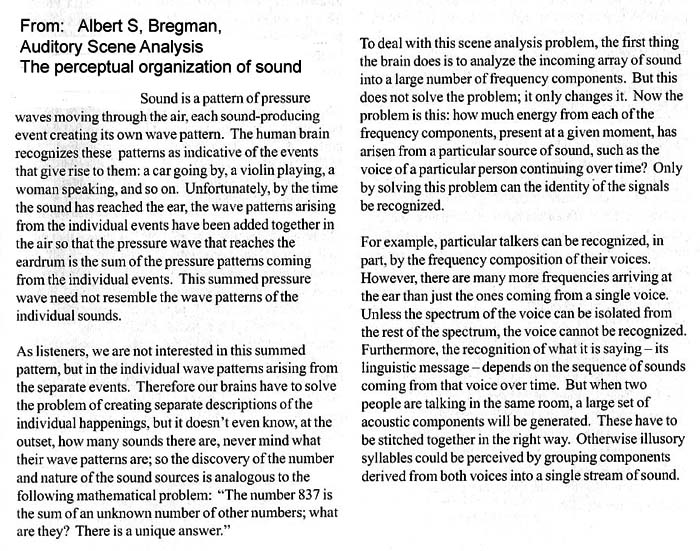
From: Albert S. Bregman and Pierre A. Ahad,
Demonstrations of Auditory Scene Analysis -
The perceptual organization of sound, Audio CD
SL: And now another of
Bregman's illustrations of the ear-brain system's capability. I like to
call that system our BSP, our biological signal processor. Imagine writing
the software for a DSP box that must function
like the BSP. If the software does not work, you will be eaten by a saber
toothed tiger.
Fitz: It would seem that
'room correction' could start a fight with the BSP.
SL: That is possible. I
judge any sound system by how tiring it is to listen to. When after a
while you feel like you had enough, then your brain is telling you
subconsciously: I have worked enough to compensate for the unnatural cues
that I receive. I am tired.
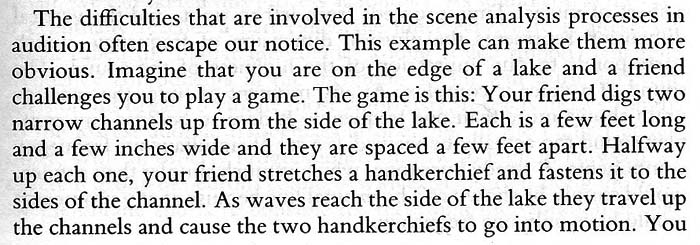
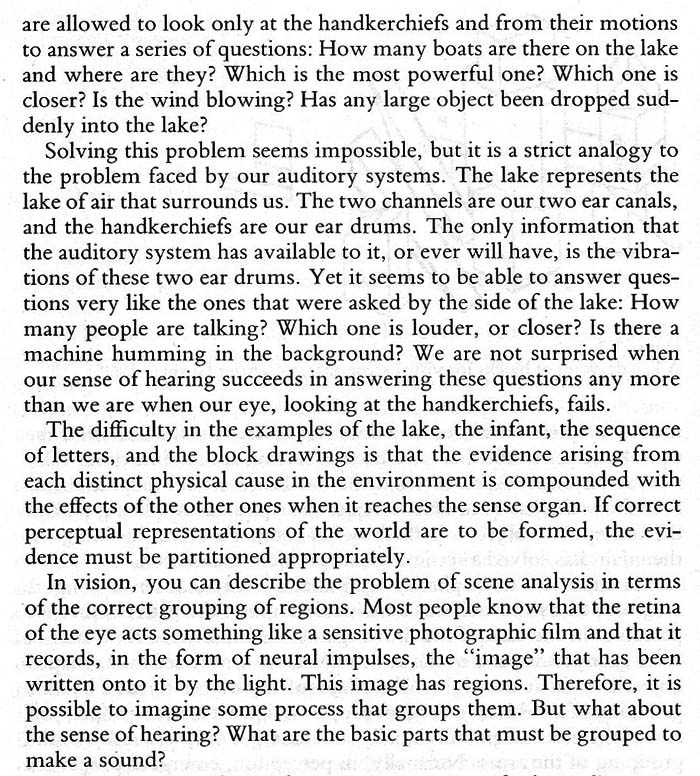
From: Albert S. Bregman, Auditory Scene Analysis -
The perceptual organization of sound, MIT Press, 1990
Fitz: That is truly
amazing.
... and what is this Theile Model all about?
SL: Well, I have to first
generate some visuals to illustrate and explain the Association Model of
auditory perception. We will talk about the philosophical concept of
Gestalt and how we experience it. And then we talk about the ear and upper
body as an encoding and decoding device for the world around us in order
that the brain can extract meaning and learning in conjunction with its
memory part.
It is not obvious at this time, but it
all relates to loudspeakers and what they must do for a listener to
recognize a Gestalt, and how therefore they should be designed and built
optimally.

2.2
- The Association Model of Perception
SL: I am
back.
I encountered the association model for
the first time in Guenther Theile's AES Journal paper, "On the
Standardization of the Frequency Response of High-Quality Studio
Headphones", Vol. 34, No. 12, 1986 December.
I noticed the model again, and this
time applied as a guide to effective coding of information, in a white
Paper by Clemens Par.
You might read the papers, if you want
more background material for our conversation about loudspeaker design and
about how and what we hear:
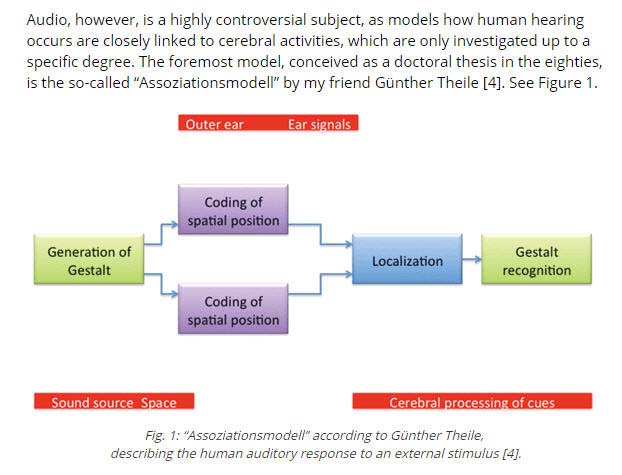
From: Clemens Par, Rationalism versus Empirism,
in https://www.intercomms.net/issue-25/va-1.html,
2015
or https://www.linkwitzlab.com/Fitz/rationalism-empirism.htm
[4] G. Theile, On the Localization in the Superimposed Soundfield, PhD
Thesis, Technische Universitaet Berlin, 1980

Here
is my friend Clemens looking to convince the engineering world to apply
sensible perceptual coding
Fitz: I will skip it for
now and maybe get back to reading the papers later.
SL: Alright, but I must
tell you that the association model gives not just a wonderful explanation
to how we hear. It applies to all our senses, the five senses through
which we experience the world on the outside of our skin:
Hearing - Seeing - Touching - Smelling - Tasting.
Fitz: How is that?
SL: I really must step
back a long way, because this is about how we interact with and respond to
the world around us. It is about the functional patterns that we have acquired
by birth from our parents and by generations before us, through the
genetic code in our bodies. It is about learning, since the first scream
at our birth into this universe, about experiencing love and pain and then
learning to get more love and how to avoid pain. It is about the influence
of 'nature' and 'nurture' upon our daily activities and longings.
Fitz: You are going big
again.
SL: It hardly gets bigger
than that. So lets start right away with the Universe.
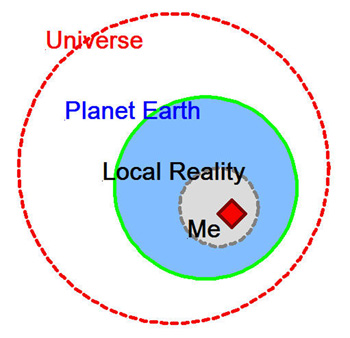
Fitz: Yes, I know that
Planet Earth and our solar system is just one of millions of solar systems
in the universe. I read that they found just recently a cluster of
planets, which potentially could carry life as we understand it, and the
planets are not that far away in terms of light years.
I know that we are not the center of
the universe, not even the center of our milky way galaxy, but some 20,000
light years away from the center and at the outer fringes of our spinning
galaxy, which is just one of millions of galaxies. It is just overwhelming
to think about it, but also awe inspiring and humbling.
SL: Yes, and then to think
that our planet is just a youngster in the universe, recycled material
from extinguished suns, from stars, which shone brightly before the earth
was born. We ourselves, the atoms, which make up our bodies were cooked in
a sun. We are literally made up of stardust. We are local condensations
and manifestations of a parent sun.
Fitz: Pretty amazing stuff
SL: And the beauty is that
we are, or can become, conscious of this relationship through the
extension of our five senses by scientific instruments, and by
communication tools that reach beyond the range of our voice or beyond the
drum beats, which were in earlier times used to send messages to people at
great distance from each other.
Fitz: OK. The picture
above shows Me inside a Local Reality, which is inside the circle called
Planet Earth.
SL: What is being
communicated here, is that we live our lives locally. In the past the
extend of that region was defined by the horizon on the water, or the next
mountain range, or the forest, or basically by how far we could see.
Compared to that, the local reality for hearing, what you can perceive in
terms of spatial information with closed eyes, is different in its
extension and detail. Touch is limited by the reach of your arms or legs.
Fitz: But today my Local
Realty is far greater, because I have a smart-phone and ear-buds and a car
and Facebook and Google.
SL: Yes, very true. But I
still call it Local Reality, because you have self imposed boundaries,
which determine how far you reach. You have a local world to which you
respond. I have another one. Since you are on my website, our worlds have
some amount of overlap.
The point of all of this, is that we
deal with, that we experience and live in a bounded world. We can
transport ourselves by foot, bicycle, car or airplane to different bounded
worlds. Taken together, all these add to and form our experience and
learning of the world beyond our skin. We carry in our head and body
memories, thoughts, emotions, behavior patterns and models as a result of
our journey through life. The journey started with birth. We all came into
this world pretty much the same way. We go out in our own unique way.
Between those two events we live the story of our life.
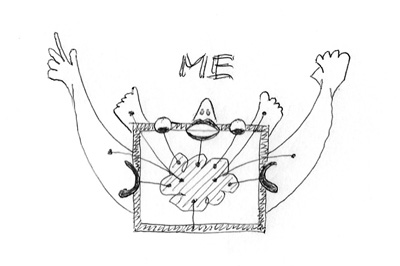
SL: How the story is being
written depends upon the inputs and messages, which we have received in
the past, and what and how we have internalized them. The story depends
upon the inputs, which we receive at every moment and how we respond to
them. But the story also develops in response to our resistances,
expectations and hopes.
The difficulty for our perceptual
apparatus, for hearing and seeing for example, is that we are constantly
exposed to information from our local reality.
When I open my eyes in the morning, I
see the reflections of the sunlight, which describe the objects in my
bedroom and the objects outside the bedroom window. Since I have memory,
which I associate with what I see now, I am not so much interested in the
scenery and landscape, but I am looking for what has changed since
yesterday. For example I like to know what today's weather is going to be.
I know from experience that last night's weather report is not a reliable
predictor here, on the Pacific coast of Northern California, where the fog
drifts in and out, and the weather can change from sunny to foggy within
an hour or two. So the weather has my attention.
Now if I stand up to look out the
window, I notice whether the long grasses or any tree branches move, and
if so, in which direction. Having been an avid, a practically addicted
windsurfer, I cannot help but noticing the smallest movements caused by
air, and hopefully indicating a windy day. I no longer dare to go out on
the water, aging has its consequences, but I still respond to patterns,
which I adopted in earlier times. Water, wind and waves are still calling,
when my pleasure now is to wade through the cold waters along a sandy
beach near our home.
Fitz: OK, why are you
telling me this?
SL: I am telling you this
because our perceptual apparatus has to divide the world we live in into
foreground and background. Otherwise we cannot handle the inflow of
information. We need to know what is background, what is consistent, what
does not require attention, in order to notice changes in the background,
which might carry information, to which we better pay attention. It is the
movement against a background, whether it is a visual or a sonic
background, which draws our attention.
As a matter of fact, all our senses are
primarily change detectors. Come into a room and it smells bad. After a
while you no longer notice it. But then go out the door and you will
relish the fresh air.
Fitz: It's the same with
hearing. I get really annoyed with clicks and ticks on my old LP's and
often wish I could just ignore them.
SL: That is difficult to
do. You can much more easily ignore tape hiss or LP groove noise, because
it is continuous, Your brain can move that beyond its acoustic horizon.
But is has to constantly work at it and it becomes tiring. Some
audiophiles like to talk about new equipment brake-in. I think it is
mostly their brain breaking in, because the brain has plasticity, and is
eventually adapting to the reality. The longer the break-in time, the more
artificial the sound must have been.
The clicks and ticks though draw your
attention, because you are genetically programmed to pay attention to such
signals. In evolutionary terms, there could be a saber toothed tiger in
the bushes. We still respond to the commands from a large region in our
brain, which is programmed for bodily response and motion, like hiding or
running.
SL: Our conversation now
brings me to the Association Model of Perception, or AMP. The general
model came to mind as I was thinking about the steps and processes in the
Association Model of Hearing, which GuentherTheile and then Clemens Par
used for their particular lines of investigation.
I also have been fascinated by books
like:
Cesar Hidalgo, "Why Information Grows", 2015
Daniel Kahneman, "Thinking, Fast and
Slow", 2011
Michael S. Gazzaniga, "Who's
in Charge?", 2011
Pierre Teilhard de Chardin, "The
Phenomenon of Man", 1955
The model below brings together what I
have taken from various inputs, from my own life's story and from
recognizing what is hidden behind "The Open Secret" of life and
living.
Fitz: So you have tested
this model against your experiences and understandings?
SL: Yes. The beauty of
this model is that it not only brings to consciousness the patterns in my
response to the realities beyond my skin, but also to a dimension beyond,
which touches and enters me through Intuition and Recognition.
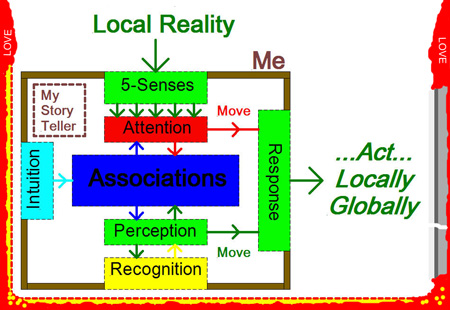
Association Model of
Perception
Attention }--
Movement --{ Perception
SL: During Intermission it
occurred to me that the Association Model of Perception is as
important to understanding life and living, as is Einstein's (e = mc2)
to understanding physics.
The AMP describes how we take in
the outside Reality and deduce from our perspective a Subjective Reality,
which has Meaning to us in context of previous observations of Reality. We
associate current input data with stored memory data, many of which are
hard to access directly, and we respond accordingly: physically, mentally,
emotionally and intuitively.

SL: I perceive my physical
environment via five sensory transducers: eyes,
ears, skin, tongue and nose. Electrical signals from the sensors are
transmitted to the brain, which then deduces from them a model of the
physical environment. The brain takes into account associations with
memories, emotions, love, fear, traumas, pain, suffering, death, love,
acceptance, laughter, joy, feelings, thought forms, beliefs, knowledge,
education, patterns of thought, skills, convictions, experiences, etc,
etc.. This can be a time consuming process before perception and cognition
occur.
Survival of the species requires fast
processing of incoming data, which is done by sorting the incoming data
streams into static data streams and transient data streams. Transient or
changing data streams get first attention. The external visual or acoustic
scene is divided into background and foreground. The foreground gets
attention and a response, which is most appropriate in the context of the
present background. Decisions have been made and actions taken before I am
even aware of what has happened. This occurs in the part of the brain,
which is hard-wired for survival and with which I was born.
Perception and recognition, which occur
after the input data has been processed via associations, leads to
completely subjective responses. They are often not appropriate in the
context of the external reality. They are instead responses, which come
out of various forms of resistance to the external reality.
The Story Teller in your head is the
commentator on your journey through life, which may take you from
Self-consciousness to Consciousness of Relationships and Connectedness, to
Enlightenment, and/or through Grace to Recognition. Along the way your
story teller is ready to come up with excuses, justifications and explanations
for all your actions and inactions.
Regardless of the nature of the
actions, and the consciousness with which they are done, they take place
in an all encompassing energetic field of LOVE. That is difficult to
accept, but becomes apparent when resistance is dropped.
SL: The song "Celestial
Echo" from the Boris Blank and Malia album
"Convergence" is about a story teller. Which story do you tell
yourself?
Fitz: I want to go back to
the two modes of mental operation. The first mode comes from my
instinctive/intuitive side. The second one is from my subjective
perception of reality, after the input data have been filtered by
associations and maybe some intuition.
SL: Yes, and the whole
journey through life is one of paying attention to inputs and to respond
physically, mentally, intuitively and emotionally. What needs to be
learned, is that resistance is futile. Battles are fought for Peace, not
for Domination. Ours is a planet of Balance.
Fitz: And what about AMP
and
Attention }-- Movement --{ Perception
SL: AMP is just the
acronym for Association Model of Perception.
AMP also has in it the first letters of Attention, Movement and
Perception.
Movement, response, action or inaction are the outcome of attention and
perception.
I have heard neuroscientists say that
the prime purpose for the brain is to control movement of the body. Think
about it. What would you do and be, if you did not have a brain? If you
could not move and program the brain with experiences of your environment?
To instigate new movements? To learn from associations? A tree does not
need a brain. It is genetically hard programmed to go for the sunlight.
Fitz: Can you give me an
example of how my own mind works when it comes to the two modes of
operation?
SL: I love to show you
this page from Kahneman's book about 'Thinking, Fast and Slow'. In his
terminology System 1 is the fast one and System 2 is slow.
Have fun:
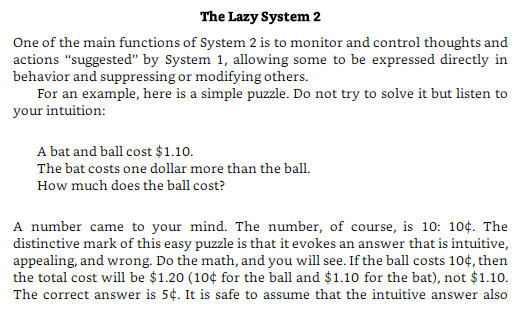
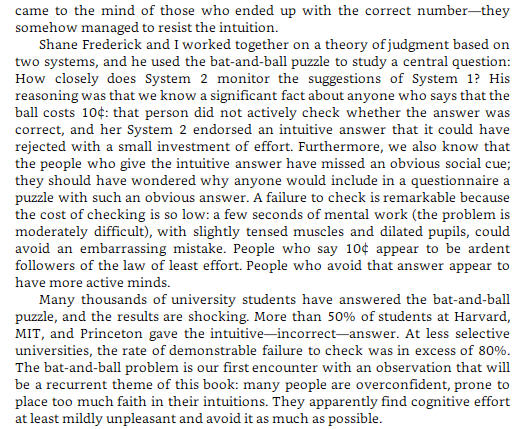
Fitz: Great! What was your answer?
SL: 10 cent
Note that you just had an experience of
your inner workings, how your mind processed the bat and ball question. We
perceive not only the world outside of the skin but also the world inside
of the skin. We perceive our state of being, though it is tainted by the
associations, which are dominant at the moment and which give us the
context for the present state of being. Observe how you answer the
question: "How are you?"
Note also that in general, perception
works against a background, a context. Foreground versus background. A
perception derives its meaning from the context. If it is pitch dark and
you hear a noise that reminds you of a mouse, then you ask yourself: Does
that sound make sense here in this fancy hotel room?
When I listen to the playback of a
stereo recording and close my eyes, I ask myself: Where am I?
My enjoyment of the performance is greatly enhanced, when I do not hear
left and right loudspeakers and the listening room, and only a phantom
acoustic scene. If the perceived scene is 3-dimensional and naturally
arranged spatially, and in a plausible environmental context, then I love
to immerse myself most fully into experiencing the music. And that can get loud to a
disinterested bystander.
"Musik wird oft nicht schön
empfunden, weil stets sie mit Geräusch verbunden", said the
cartoonist Wilhelm Busch a long time ago.
SL: OK, let's move
on.
I now I have laid the basis for talking about the specifics of hearing and
how we process acoustic vibrations into meaningful perceptions. After my
detours into general principles of perception, life and living we are back
to how we are programmed to listen to loudspeakers.
SL: And before I forget I
must point you to a book, which illustrates in numerous examples how the
AMP is being gamed for financial gain everywhere you look: "Phishing
for Phools - The Economics of Manipulation and Deception" by
George A. Akerlof and Robert J. Shiller, 2015.
SL: I have annotated the
block diagram for the Association
Model of Hearing to help explain it.
Let's assume we are at a cocktail party. There are groups of people and
everybody is talking. That is a lot of noise or air vibration, all of
which carries information. Since you always wanted to talk to Fred about
your speaker project, you seek him out in the crowd of people, and move
towards him, to engage him in a conversation. You call out his name, to
get his attention.

SL: By now being close to Fred you are
in a different Gestalt of the cocktail party, than you were in, when you
looked for him. But it is still terribly noisy and you have to turn your
right ear towards Fred to understand him. Fred's voice and words have your
attention and you positioned yourself optimally to discriminate against
other voices.
By doing so your right ear receives a higher signal
level and more high frequencies from Fred's voice than your left ear,
because your head blocks sound from reaching the left ear. The electrical
signals from your ears have been coded with spatial position of your head
and with your spatial position in the room relative to all sources of
noise/sound/voice.
By associating the spatially coded information from
the ears with stored memories and learning, the air vibration Gestalt is
recognized as Fred's voice and many people talking at a cocktail party.
The brain also knows how to correct for the unequal signals at the ears
from Fred's voice, so that he sounds the same in timbre, whether you look
at Fred or turn your head.
Such spectral correction of ear signals is important
for tracking the location of a moving source, which has drawn your
attention, relative to other sources of sound, which could be real or
could be reflections coming to you from the environment of the moving
source.
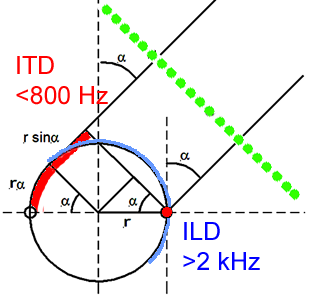
See: A
model for rendering stereo signals in the ITD range of hearing
Turning of the head is used to determine the
direction from which a sound is coming. The ears are spaced by about 17 cm
= 2r, which corresponds to half a wavelength at 1000 Hz. That corresponds
to 180 degrees of phase shift between ear signals. A signal, which reaches
both ears from an angle a will have a phase shift between the ear signal
outputs to the brain. Below 1 kHz the phase shift is unambiguous, but
above 1 kHz a polarity reversal will bring back the same phase shift.
Nature prefers the path of least resistance and so uses phase shift only
below 1 kHz for finding direction. Actually, it is the inter-aural time delay,
ITD, the group delay below 800 Hz, which is used. Above 2 kHz it is
the ILD, the inter-aural level difference due to head blockage for higher
frequencies, which is used to find sound direction.
The spatial coding that takes place in the outer and
inner ear is quite fascinating.

From: David M Howard & Jamie Angus,
"Acoustics and Psychoacoustics", Focal Press, 2006, Chapter 2.1
The pinna of the outer ear collects the
N superimposed sound streams and combines them into a single stream in the
auditory canal. The air pressure variations in the auditory canal move the
eardrum, the tympanic membrane. The middle ear is essentially an impedance
transformer, which converts the pressure variations in the air of the ear
canal, to pressure variations in the fluid, which fills the Cochlea.

See also: J. Blauert (Ed.),
Communication Acoustics, Springer 2005
Fitz: So far, so good.
SL: The drawing above
shows four sound stream excerpts and coming from different directions, A,
B, C and D versus time markers 1, 2, 3, 4, 5 and 6.
The dots represent pressure peaks of an acoustic Gestalt G1(t, p, L),
which means G1 is a function of time t, of air pressure p, and of location
L of the outer ear in space.
In the ear canal location L1 the four streams are converted to pressure
variations p1(t, L1) by summation of the four streams.
The middle ear couples the ear canal to
the cochlea by levers, i.e. by a mechanical impedance transformer, which
increases the force generated by the eardrum motion to push with greater
force on the fluid in the cochlea and to set up a traveling wave.
The wave travels over a basilar
membrane, which responds to the spectral content of the wave. The
beginning of the membrane generates electrical impulses in response to
high frequency components and the far end of the membrane responds to low
frequency content. The auditory nerve strand, which takes the
electrical signals from the basilar membrane to the brain now carries both
sound pressure information p1(t, L1) and frequency information F1(t, p1).
The brain can turn the head and thus get another data set. From all that
information and in connection with associations we recognize the Gestalt
G1.
-
Gestalt
recognition is based on CUES
-
Two ears with
fixed separation, and an obstruction between them, sample the
sound-field of the original acoustic Gestalt.
-
The sampling
points can be turned and moved, thereby encoding the input data with
spatial and spectral information cues
-
The brain
decodes the incoming data streams by association with cues from memory
-
The recognized
Gestalt is always SUBJECTIVE and is a sampling of the original
acoustic Gestalt combined with ASSOCIATIONS
-
What you hear is
subjective
|
|
|
Gestalt
Generation and Gestalt Recognition |
|
|
|
Hearing Process ---
Algorithm, Strategy, Tactics --- Actions |
|
|
| 1 |
Air pressure variations can carry
information, which propagates out from a source in time and
travels over distance, being progressively dispersed until
the pressure wave is dissipated. |
|
|
| 2 |
Information comes in a sequence of packages,
which are streamed |
|
|
| 3 |
Streams are collected by the outer ear and
bundled in the ear canal. Ear shape, head and upper torso
affect the collection |
|
|
| 4 |
Behind the ear drum the bundled stream is
converted into electrical impulses, which are then streamed
to the brain |
|
|
| 5 |
The bundled streams from the two ears are
different, because
the ears are in different locations in space |
|
|
| 6 |
Turning the head changes the streams at each
eardrum. The changes in eardrum streams relates the sound
source location relative to where the nose points |
|
|
| 7 |
The brain looks for patterns in left and
right ear streams |
|
|
| 8 |
Separating bundled streams into acoustic
space background and foreground information
Echoes are irrelevant for locating a source, but reflections
must be qualified depending upon their direction and timing. |
|
|
| 9 |
Having found a signature the brain assigns
meaning to it by associating it with memory patterns and
memory objects |
|
|
| 10 |
If meaning indicates possible danger, then
the brain calls for further attention leading to immediate
action in the form of hiding, running or getting ready to
fight |
|
|
| 11 |
In order to act appropriately the brain must
know the location of the danger, its direction, distance and
movement |
|
|
| 12 |
Comparing left and right ear streams for the
danger's direction |
|
|
| 13 |
Establishing/tracking direction and distance
by head turning |
|
|
| 14 |
Estimating size of sound object by its
proximity and loudness |
|
|
| 15 |
Recognizing the Gestalt by association with acoustic
space, memory objects, feelings, emotions |
|
|
| 16 |
Opening eyes: Confirming
Gestalt by sight |
|
|
| 17 |
Action choices:
fight, flee, hide, surrender, relax, accommodate,
enjoy |
|
|
|
How do you respond?
Why?
GRACE
======= to respond without resistance =======
BEING
SL: Remember, earlier on
we talked about the Zen master asking the student about the sound of a
falling tree, about one hand clapping, and about the student asking:
"What is the essence of
Buddhism?" And the master answered: "No Self, no problem!"
Fitz: Yes, and I said:
"That gets heavy.
Let's talk about hearing".
SL: Hearing is part of
life and living. So if you ask me: "What is the essence of life
and living?",
the answer is: "to respond without resistance".
2.6
- In summary

A cultural aspect to
spatial hearing:
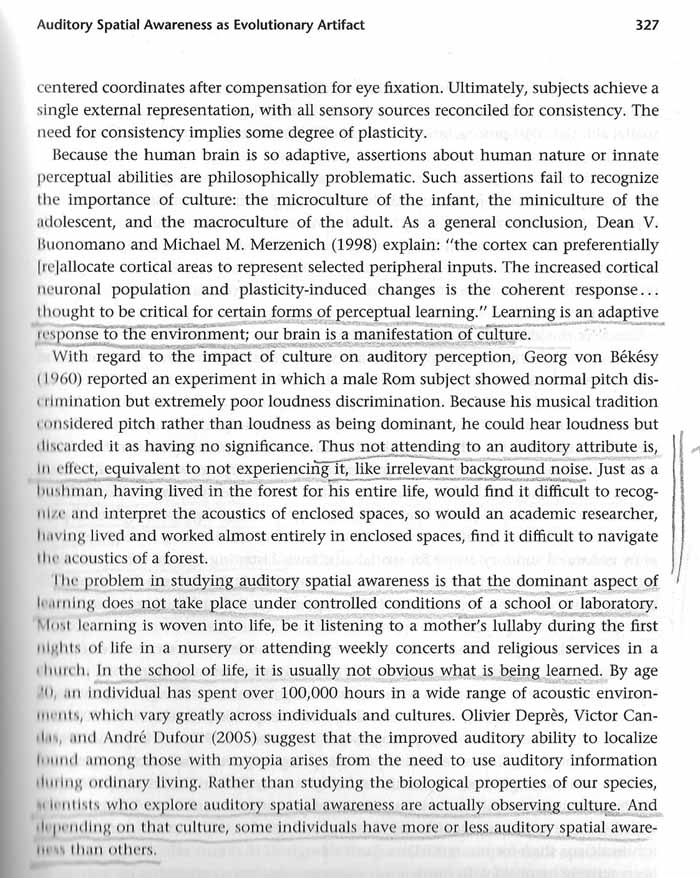
From: Barry Blesser & Linda-Ruth
Salter, "Spaces speak, are you listening?", 2007
Reading material and
sound examples
Daniel J. Levitin, "This is Your Brain on Music",
2006
David M. Howard & Jamie Angus, "Acoustics and
Psychoacoustics", 1996, 2006
Sound examples:
Ripping paper
Guitar
SFO streets
Symphony exit
Applause and inverted applause
Audio
productions
Information
processing
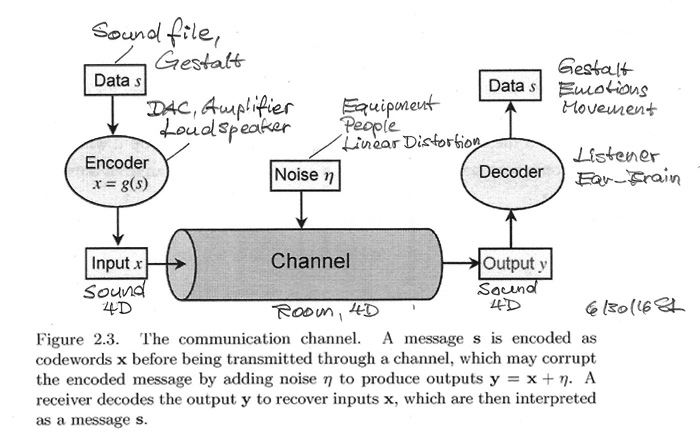
From: James V Stone, "Information
Theory - A tutorial introduction", 2015
From f-input
channels via two bitstreams to h-output channels
and with preservation of spatial information

From: Clemens Par, "Rationalism versus
Empirism", 2014
SL: That should be
enough for now about Acoustics and Hearing and it becomes time to continue
with:
3 - Acoustics and
Mechanics
Next
page
|